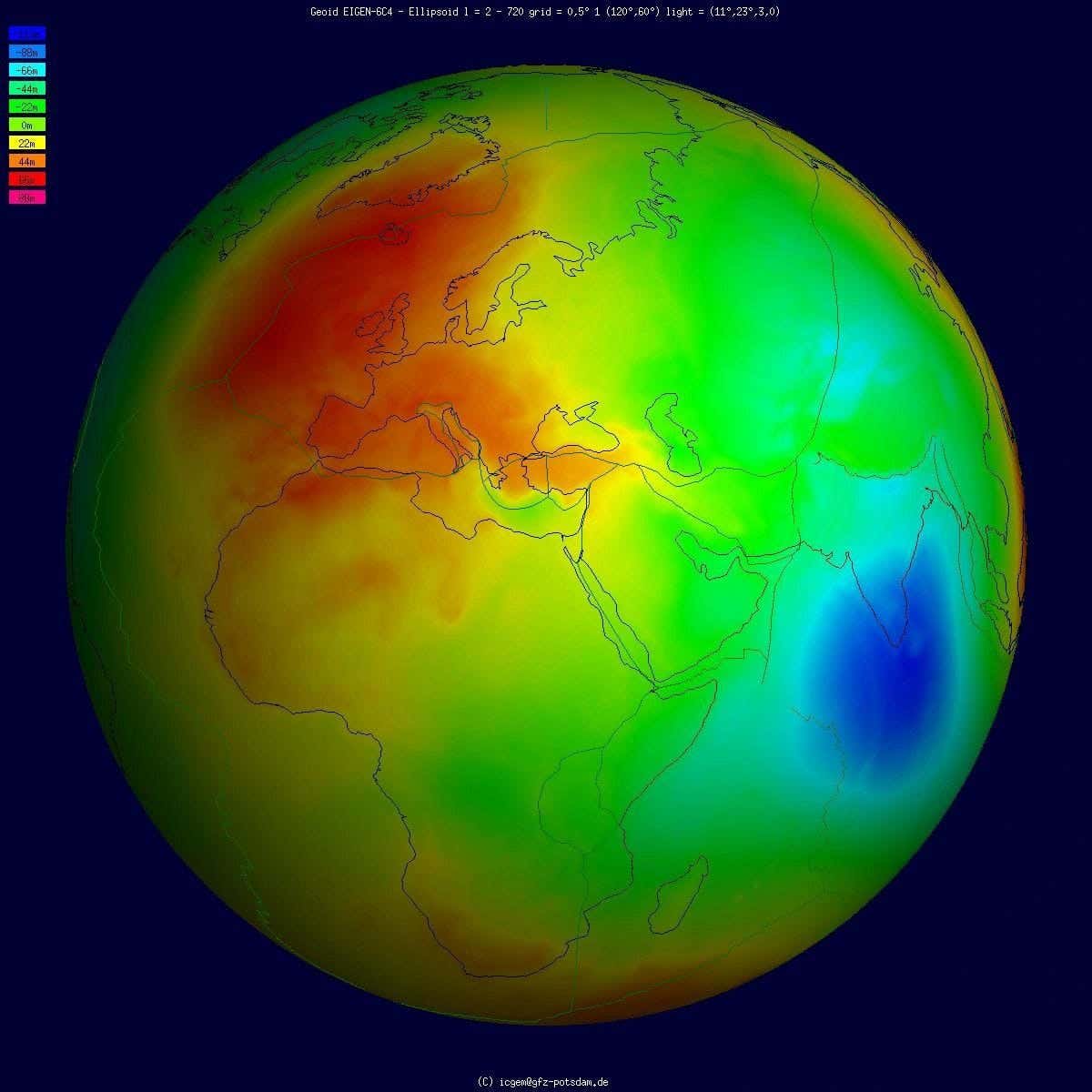Giant “Gravity Hole” discovered in the Indian Ocean
Mantle convection involves movement within the mantle, where hotter, lighter material rises, and cooler, denser material sinks due to gravity

The Earth beneath your feet is far from still. While we understand quite a bit about the Earth’s surface, the interior remains a mystery. (CREDIT: International Centre for Global Earth Models / Wikimedia, CC BY 4.0)
The Earth beneath your feet is far from still. While we understand quite a bit about the Earth's surface, the interior remains a mystery. Despite our technological advancements, we have yet to design probes that can reach even the base of the crust, just 35 kilometers deep. To learn about the Earth's core and mantle, we rely on indirect methods.
The Earth might appear as a uniform blue sphere, but it's more like a deformed potato due to non-uniform gravity caused by the unequal distribution of matter inside the planet. Tectonic plate movements create mountains and valleys, adding to these deformations.
Since oceans cover 71% of the surface, these irregularities affect the ocean's shape as well. Without tides and currents, ocean water would settle into a smoothly undulating shape called a geoid, rising where gravity is high and sinking where gravity is low. These uneven surfaces, known as "geoid anomalies," result from the mass distribution within the deep Earth.
One such anomaly is found south of Sri Lanka. The Indian Ocean Geoid Low (IOGL) spans a vast area and is characterized by a significant gravity low, where the ocean surface plunges 106 meters. The IOGL, sometimes called a "gravity hole," has puzzled geologists for decades.
“The existence of the Indian Ocean geoid low is one of the most outstanding problems in Earth Sciences. It is the lowest geoid/gravity anomaly on Earth and so far no consensus existed regarding its source,” says Prof. Attreyee Ghosh, an Assistant Professor at the Centre for Earth Sciences, Indian Institute of Science, Bangalore.
In a recent study published in Geophysical Research Letters, Prof. Ghosh and her colleagues, along with researchers from the GFZ German Research Centre for Geosciences, investigated the missing mass causing the geoid low. Past studies attributed it to a remnant of an ancient plate that dived into the mantle beneath another plate millions of years ago, but there had been no convincing explanation until now.
Using numerical models of mantle convection, the researchers explained the mass deficit. Mantle convection involves movement within the Earth's mantle, where hotter, lighter material rises, and cooler, denser material sinks due to gravity. This movement was driven by seismic tomography models, which use seismic waves to create a 3-dimensional picture of the Earth's interior.
Related Stories
The researchers discovered that 'low-density anomalies'—the presence of lighter materials in the upper to mid-mantle beneath the IOGL—caused the gravity low in this region. Mantle plumes, or rising abnormally hot rock, can result in low-density anomalies.
However, no known mantle plume exists beneath the IOGL. Instead, they found hot material rising from the African large low-shear-velocity province (LLSVP) or the African superplume, near the IOGL, which gets deflected eastward and terminates beneath the IOGL. The deflection is possibly due to the fast motion of the Indian plate.
The researchers used supercomputers to simulate how the area could have formed, going as far back as 140 million years. "The Earth is basically a lumpy potato," said Ghosh. “Technically, it’s not a sphere, but what we call an ellipsoid, because as the planet rotates, the middle part bulges outward.”
To find a potential answer, Ghosh and her colleagues used computer models to set the clock back 140 million years in order to see the big picture, geologically. "We have some information and some confidence about what the Earth looked like back then,” she said. “The continents and the oceans were in very different places, and the density structure was also very different.”
From that starting point, the team ran 19 simulations up to the present day, recreating the shifting of tectonic plates and the behavior of magma inside the mantle. In six scenarios, a geoid low similar to the one in the Indian Ocean formed. The distinguishing factor in all six models was the presence of plumes of magma around the geoid low, believed to be responsible for the formation of the "gravity hole."
The plumes themselves originated from the disappearance of an ancient ocean as India's landmass drifted and eventually collided with Asia tens of millions of years ago. "India was in a very different place 140 million years ago, and there was an ocean between the Indian plate and Asia. India started moving north and as it did, the ocean disappeared, and the gap with Asia closed," Ghosh explained. As the oceanic plate went down inside the mantle, it could have spurred the formation of the plumes, bringing low-density material closer to Earth's surface.
“A geoid low or a negative geoid anomaly would be caused by a mass deficit within the deep mantle. Our study explains this low with hotter, lighter material stretching from a depth of 300 km up to ~900 km in the northern Indian Ocean, most likely stemming from the African superplume,” says Prof. Ghosh.
The geoid low formed around 20 million years ago, according to the team's calculation. It’s hard to say whether it will ever disappear or shift away. "That all depends on how these mass anomalies in the Earth move around," Ghosh said. "It could be that it persists for a very long time. But it could also be that the plate movements will act in such a way to make it disappear — a few hundreds of millions of years in the future."
Dr. Alessandro Forte, a professor of geology at the University of Florida, believes there is good reason to carry out computer simulations to determine the origin of the Indian Ocean geoid low. However, Forte identified a couple of flaws in the study’s execution.
“The most outstanding problem with the modeling strategy adopted by the authors is that it completely fails to reproduce the powerful mantle dynamic plume that erupted 65 million years ago under the present-day location of Réunion Island,” he said. "The eruption of lava flows that covered half of the Indian subcontinent at this time — producing the celebrated Deccan Traps, one of the largest volcanic features on Earth — have long been attributed to a powerful mantle plume that is completely absent from the model simulation.”
Another issue, Forte added, is the difference between the geoid, or surface shape, predicted by the computer simulation and the actual one: “These differences are especially noticeable in the Pacific Ocean, Africa, and Eurasia. The authors mention that there is a moderate correlation, around 80%, between the predicted and observed geoids, but they don’t provide a more precise measure of how well they match numerically (in the study). This mismatch suggests that there may be some deficiencies in the computer simulation.”
Ghosh acknowledged that not every possible factor can be accounted for in the simulations. "That’s because we do not know with absolute precision what the Earth looked like in the past. The farther back in time you go, the less confidence there is in the models. We cannot take into account each and every possible scenario, and we also have to accept the fact that there may be some discrepancies on how the plates moved over time,” she said. “But we believe the overall reason for this low is quite clear.”
This study is a significant step in understanding the IOGL, providing a credible explanation for one of Earth's most intriguing gravitational anomalies. Future research will continue to refine these models and explore the complex dynamics of Earth's interior.
Note: Materials provided above by The Brighter Side of News. Content may be edited for style and length.
Like these kind of feel good stories? Get The Brighter Side of News' newsletter.
Joseph Shavit
Head Science News Writer | Communicating Innovation & Discovery
Based in Los Angeles, Joseph Shavit is an accomplished science journalist, head science news writer and co-founder at The Brighter Side of News, where he translates cutting-edge discoveries into compelling stories for a broad audience. With a strong background spanning science, business, product management, media leadership, and entrepreneurship, Joseph brings a unique perspective to science communication. His expertise allows him to uncover the intersection of technological advancements and market potential, shedding light on how groundbreaking research evolves into transformative products and industries.



